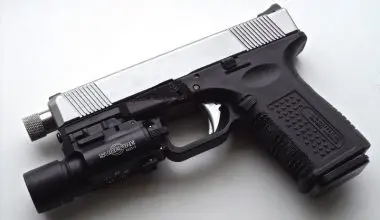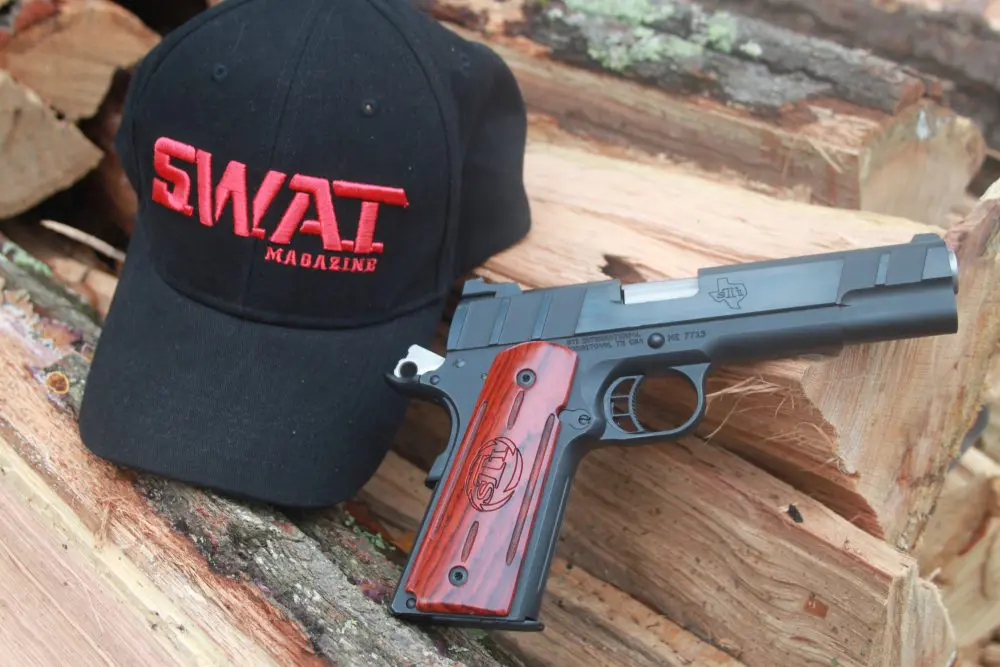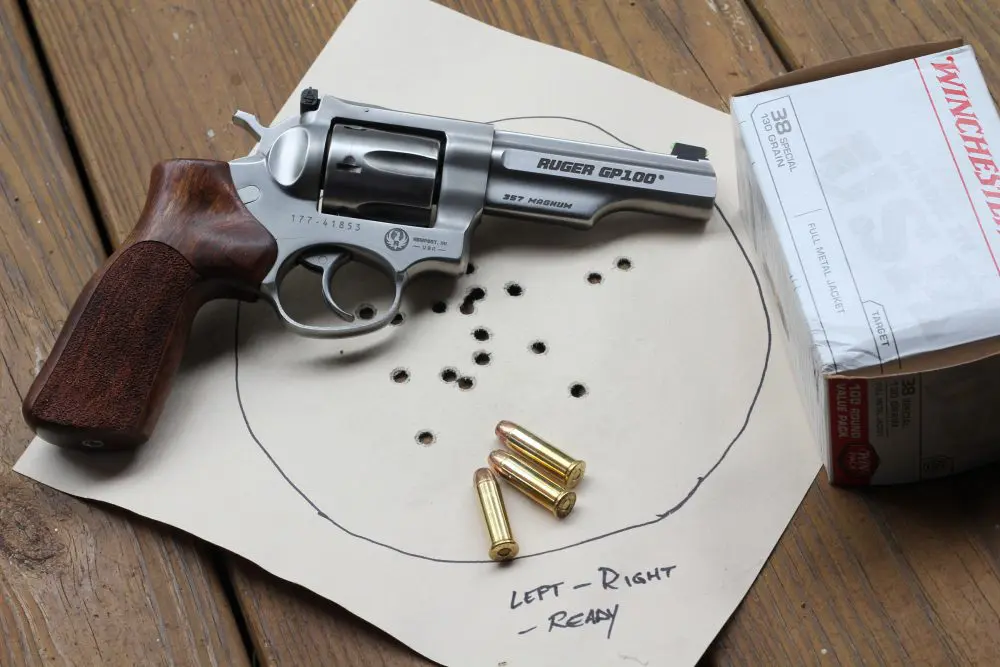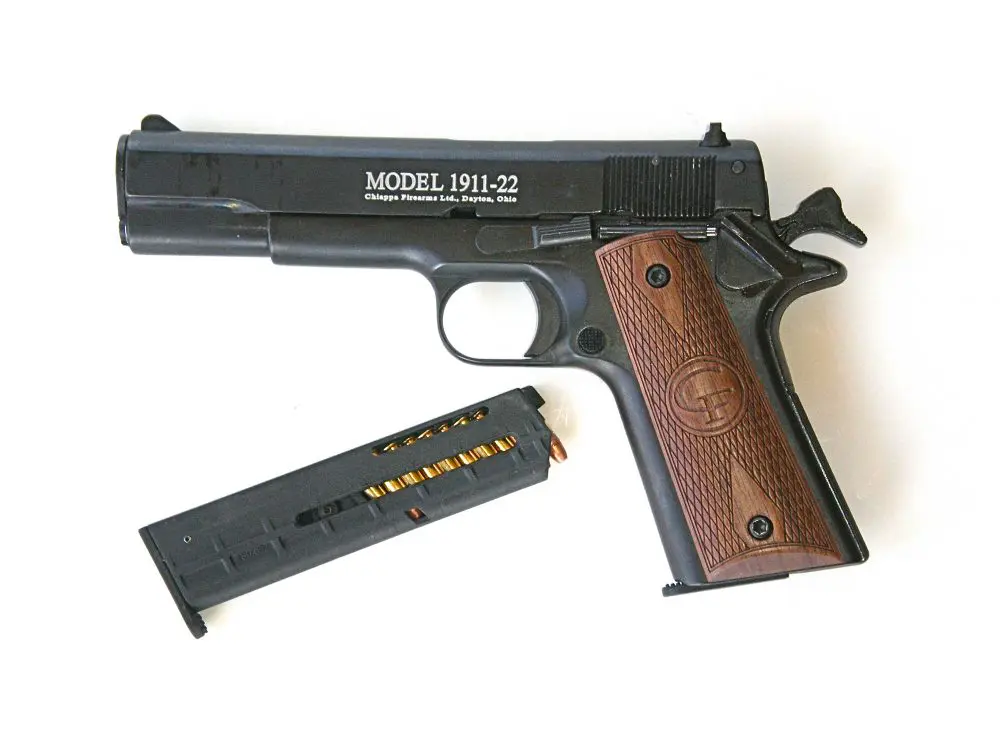
After four years of development, Heckler & Koch has released the VP9, their new polymer-framed striker-fired 9mm. This pistol bases its design on their hammer- fired P30 but has some major divergences. This article will evaluate the new pistol and take a look at its hammerfired parent.
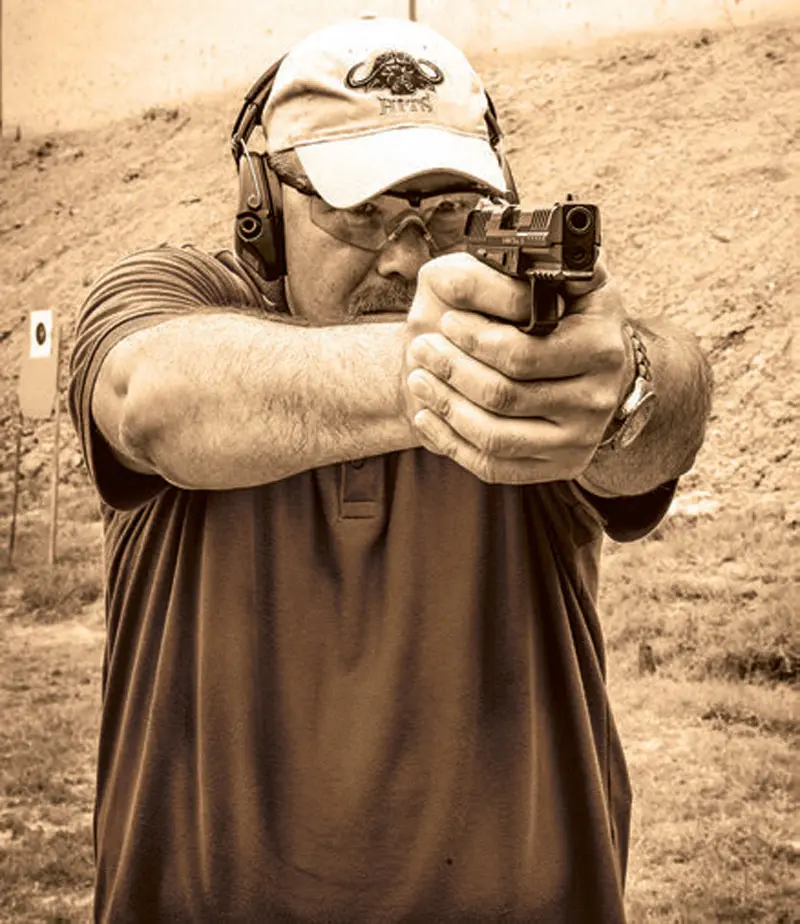
A striker-fired mechanism typically results in a pistol that is simpler and less expensive to manufacture and easier to maintain. The last two factors are important considerations for military and law enforcement contracts. Not since the end of production of their iconic P7 has Heckler & Koch offered a striker-fired pistol.
Heckler & Koch’s first polymer-framed handgun, the long discontinued HK VP70, was striker fired. They have advanced a long way since then with polymer-framed guns, beginning with the USP family of pistols that was introduced over 20 years ago.
Table of Contents
POLYMER-FRAMED HKs
All polymer-framed HKs, from the USP to the latest HK VP9, are solidly made. They feature polygonal-bored hammer-forged barrels for greater strength, accuracy and wear resistance. All their slides are made from high-strength steel, with HK’s “Hostile Environment” corrosion-resistant finish standard.
HK manufactures all their parts themselves rather than subcontract any out. This allows them to maintain high quality control and avoid the inconsistency problems that have surfaced with some other manufacturers.
The USP evolved into the P2000, which introduced an ambidextrous magazine release and slide release as standard features. This design philosophy carried forward to the HK45 and the P30 as well as the new VP9. While the P30’s left side slide release doubles as a takedown lever, the VP9 employs a separate takedown lever.
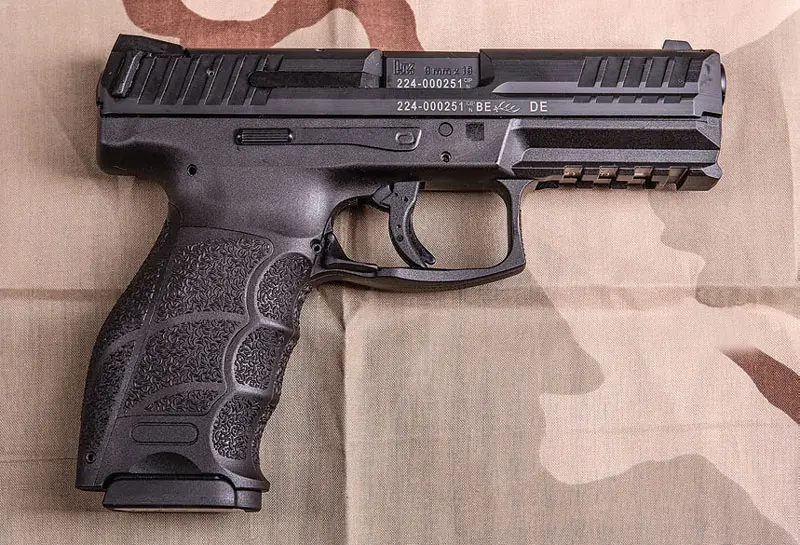
P30 EVOLVES INTO VP9
As mentioned, the HK VP9 is an evolution of the P30. Introduced in 2006, the P30 was first developed as a 15-round 9mm service pistol for German police agencies. It was the first HK pistol to incorporate a standard Picatinny rail rather than the HK proprietary rail that came on previous HK polymerframed pistols starting with the USP.
The P30 comes in a variety of trigger configurations, from traditional double-action (where the first shot is double-action with subsequent shots in single-action), to double-action only, and HK’s LEM trigger. The LEM, short for Law Enforcement Modification, features a long trigger take-up before a consistent breaking weight.

The P30 later became available with an optional ambidextrous thumb safety that allowed it to be carried cocked and locked, designated the P30S.
One disadvantage of offering these different fire control trigger configurations in a hammer-fired gun was that the P30 required more room in the slide and grip to accommodate these different options. This meant a higher slide height and more area taken up in the rear of the frame. By going to a striker-fired mechanism, the height of the slide can be reduced and the backstrap extended higher and a tad deeper.
This translates into a lower bore axis on a gun that can be gripped higher up in the rear for better control. It also makes the gun feel more comfortable in my hand, a sentiment echoed by many who test fired the pistol.
BACKSTRAPS AND GRIPS
Both the P30 and VP9 come with three different sized backstraps and an equal number of side panels for both the left and right sides of the grip. These nine modular fittings can be used in any combination to allow the end user to configure the gun to best fit his hand and shooting style.
I learned through experience that the backstraps and grips that may feel the best in your hand may not necessarily be the ones that suit you the best for shooting. A bit of experimentation may be in order. The P2000 was the first HK pistol to feature three different sized backstraps, while the HK45 and HK45C each come with two.
Like the P30, the VP9’s grips incorporate three wide finger grooves, dubbed “Spiderman grips” by some because of their weblike design. While I was skeptical about these grips when I first encountered them in 2007 on the HK45, I immediately found them to be very comfortable and quickly came to prefer them over the straight grips of the older USP and P2000 line.
A fine pebble grain stippling is molded onto the grip where the three support fingers grasp. The HK VP9 introduces a subtly different texturing that is both “grippier” and more comfortable.

DIMENSIONAL DIFFERENCES
The P30’s original barrel length was 3.85 inches, giving it an overall length of 6.95 inches. A later version became available with a barrel and slide that were slightly more than half an inch longer, known as the P30L, that later became available with the thumb safety as the P30LS. The HK VP9 has an overall length of 7.34 inches with a 4.09-inch barrel. It also has a slightly longer trigger guard than the P30 to allow more room for a gloved finger.
These dimensional differences mean the new gun won’t properly fit into holsters designed for the P30 or P30L. I wound up running the VP9 from a Raven Concealment holster designed for the HK45. It fit with a tad bit of wiggle room.
The HK VP9 takes rear cocking serrations a step further by adding vertical ledges on both sides of the slide near the rear sights, dubbing them charging supports. While I took an instant dislike to them when I first saw the photos, as soon as I handled the gun I found them to be comfortable and ergonomic. Flat panels to replace these charging supports are available from HK, but the rear sight must be removed to swap them out.
SIGHTS
The VP9 comes equipped with three-dot luminescent sights. These sights do not contain tritium and thus need to be charged with a flashlight in order to be viewable in the dark. In our tests, they only glowed in the dark for about 30 to 45 minutes after having a bright light shone on them. They provide a nice sight picture for both fast sight acquisition and accuracy.
Since the HK VP9 can utilize any sights that fit the HK P30, tritium sights and a variety of other sight options are available.
When the VP9 is cocked, a red marking on the back of the firing pin is visible to the shooter through a channel in the back of the gun. The extractor also incorporates a red upper edge that can be felt and seen when a round is chambered.
TRIGGER: BEST EVER?
The VP9’s trigger features a small hinged center section that serves as a safety and pivots inward when the trigger is depressed, similar to that of a Glock. Since the HK VP9 lacks a manual safety, this prevents it from firing if the edges of the trigger catch on anything.
The VP9 also incorporates a firing pin block, making it drop-safe, a disconnector that prevents the firing pin from engaging except when the gun is fully in battery, and a disassembly safety that necessitates the magazine be removed before the gun can be disassembled.
HK boasts that after a lot of research, they are producing the best striker-fired trigger system on the market. There is no stacking or sponginess, but a crisp break and relatively short reset, definitely shorter than that of the VP30. The VP9s we tested reflected this.
FIELD TESTING
With the right ammo and shooter, the VP9 is capable of putting five rounds into less than two inches at 25 yards when fired from a rest. Since I’m not the right shooter, I enlisted the aid of someone who is—Wayne Dobbs.
Wayne, a retired peace officer with extensive instructing experience, is co-owner of Hardwired Tactical Shooting (FIRST RESPONDER: Hardwired Tactical Pistol Class, May 2013 S.W.A.T.).
This was Wayne’s first time shooting the VP9 and he was able to coax some sub two-inch groups out of it. Most groups ran in the 2.5- to 3.5-inch range. This had the effect of making anything larger look bad. For comparison, he also fired the HK P30LS, which often ran neck and neck with the VP9, but in some cases did not shoot quite as tightly.
Still, any day you can gripe about getting three-inch groups at 25 yards with Black Hills Ammunition is a good day. Their Tac XP +P 115-grain Barnes hollow point was dead on at 25 yards with the VP9, putting five rounds into 2.5 inches.
ABOUT THAT TRIGGER …
We preferred the HK VP9’s striker-fired trigger pull to the singleaction mode of the P30LS. Wayne pointed out that the VP9’s trigger release point was farther forward than that of the P30LS, which makes it break sooner without having to be pulled back as far. The VP9 is listed as having a 5.4-pound trigger pull. Our test model came in at just under five pounds, comparable to the single-action mode of the P30LS.
But the difference became dramatic during rapid fire. With less trigger pre-travel, farther forward breaking point, and shorter reset, the VP9 really came into its own. Also relevant were the higher beavertail, which lets the shooter attain a higher grip, and the VP9’s lower bore axis.
Even subtleties like different texturing on the grip came into play. The combination of these factors resulted in a more ergonomic and flatter-shooting gun that fits the hand better and more comfortably and is easier to shoot accurately at speed.
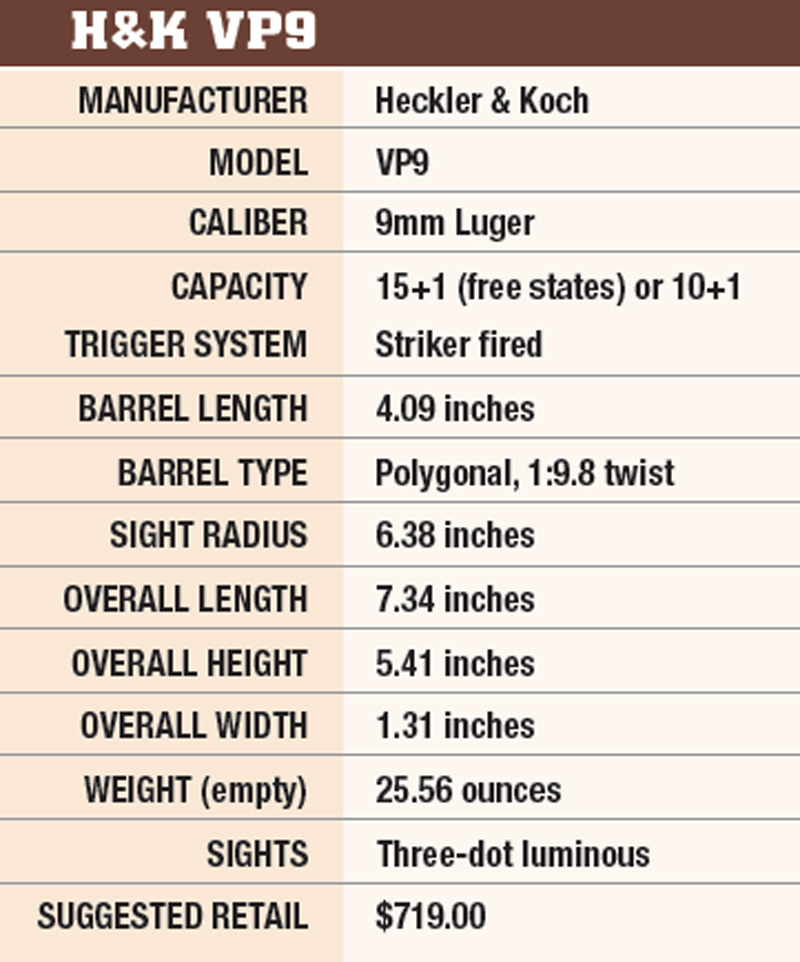
When shooting one-handed, especially from my much less practiced weak hand, I came to appreciate the VP9 trigger’s superior characteristics. Weak-hand-only shooting is a great litmus test for a trigger, because your non-dominant hand doesn’t have the strength, coordination, control, and— if you are like most of us—accumulated practice of your strong hand. The results manifested themselves dramatically on the targets.
MALFUNCTIONS = ONE
In firing over 1,000 rounds through the HK VP9, I only encountered one malfunction: a failure to feed. This occurred when shooting weak-hand only with a discount bulk brand of 115-grain FMJ. This was within the first 200 rounds through the gun.
I later fired over 100 rounds of the same ammo through the VP9 shooting weak-hand only without a single recurrence of this malfunction. Thus I’ll write the single malfunction off to a new gun with stiffer springs firing practice ammo that I would never bet my life on. Better ammo like the Black Hills used in this evaluation has never seen a malfunction over thousands of rounds in a variety of personally owned HK handguns.
I had a number of people test fire the gun, and all were overwhelmingly impressed with it. I don’t remember liking a new gun this much or having one that was so comfortable and easy to shoot accurately. So of course something was bound to go wrong….
THE “GLITCH”
The HK VP9’s slide would not slip off the way it was illustrated in the manual when the disassembly lever was depressed. At this point, I had to pull the trigger to remove the slide. After conferring with HK on the phone, I learned that I had one of the first T&E VP9s released, and it lacked a parts upgrade that allowed the slide to be removed as specified in the manual.

There was no safety issue, and I would have gladly bought the gun this way. But HK wanted to replace it. This is why manufacturers release T&E guns. Unlike the P30, the HK VP9 is being introduced in the United States before Europe. So back to H&K it went.
TWO NEW SAMPLES
At my request, HK sent me two replacement VP9s, which arrived four days later. One had factory night sights and one standard luminescent sights, which allowed me to put rounds through two more VP9s and compare the sights. Under some indoor range conditions, the dots on the luminescent sights were easier to pick up than those on the white outline tritium sights.
Both new VP9s exhibited the same accuracy as the original, as well as the same great trigger.
We put an additional 2,000 rounds through the two new VP9s and encountered no malfunctions. Included in the tests were firing weak-hand only with bulk manufactured 115-grain ammo. Both guns disassembled the way the manual specified without necessitating the trigger being pulled to remove the slide.
I took the two new guns to a range session with Wayne Dobbs and his partner Darryl Bolke, who had each received their own T&E VP9. Bolke was instrumental in helping me procure an early T&E VP9.
We didn’t spend any time shooting from the bench. Wayne fired a 2.5-inch five-shot group from an offhand unsupported position at 25 yards, then it was off to a variety of drills with some very impressive results from Wayne and Darryl.
ANOTHER THOUSAND ROUNDS DOWNRANGE
After a few hours, we had fired over 1,000 rounds through the four VP9s with no malfunctions. The only notable event was the left-side cocking support separating itself from Darryl’s gun. This did not affect its function or vulnerability to malfunctions. A quick call to H&K yielded Darryl an overnight return tag and replacement gun.
Both Wayne and Darryl were very impressed with the VP9, and consider it to be the best-shooting striker-fired service pistol on the market. This is high praise from a pair who have a combined half-century of police experience and decades of instructing a wide variety of firearms classes to numerous law enforcement agencies.
HK took the lessons and analysis of an already good gun, the P30, and made it even better with the VP9. As with the P30, a version in .40 S&W will be released in the future. Suggested retail price for the VP9 is $719, about $300 lower than that of the P30. Some retailers are already offering it for less.
It’s not the cheapest in the service pistol category, but I believe it offers the best value for dollar in terms of accuracy, reliability, ergonomics, and shootability.
